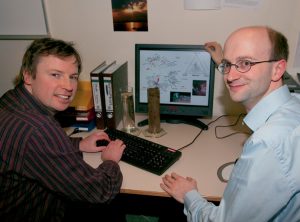Investigating the invisible life in our environment
A new comparative metagenomics method provides insights into the evolution of the smallest beings on Earth
Microorganisms make up more than a third of the Earth’s biomass. They are found in water, on land and even in our bodies, recycling nutrients, influencing the planet’s climate or causing diseases. Still, we know surprisingly little about the smallest beings that colonise Earth. A new computational method to analyse environmental DNA samples, developed by researchers at the European Molecular Biology Laboratory (EMBL) in Heidelberg, now sheds light on the microbial composition of different habitats, from soil to water. The study, which will be published in this week’s online issue of the journal Science, also reveals that microbes evolve faster in some environments than in others and that they rather rarely change their habitat preferences over time.
Studying microorganisms has proven very difficult in the past, because most naturally occurring types do not grow in the lab. The rapidly growing field of environmental DNA sequencing, called metagenomics, now helps to overcome this problem. Instead of analysing the genome of a specific organism, scientists sequence all the DNA they find in environmental samples, ranging from seawater to soil. They collect vast amounts of sequence fragments, which contain genetic information of thousands of species forming communities that colonise a certain habitat.
“We have developed a new and very precise method to classify the microbial communities that are present in a given sample,” explains Peer Bork, joint coordinator of the Structural and Computational Biology Unit at EMBL. “We first identify informative DNA sequences in a sample and then map them onto the tree of life, a phylogeny of organisms with sequenced genomes, to find out which microbes are present and where yet unknown species fit into taxonomy and evolution.”
In this way, Bork and EMBL alumnus Christian von Mering classified microbial communities present in four very different environments: ocean surface, acidic underground mine water, whale bones from the deep sea and farm soil.
“Most of the DNA we found fits into the evolutionary ancient parts of the tree of life, which means that the organisms are probably not close relatives of the species sequenced and known so far,” says von Mering, who carried out the research in Bork’s group. “Our novel method complements current classification attempts based on individual RNA molecules and also has additional unique features. It allows us to gain insight into the evolution of microbes in the context of their habitats.”
Comparing the datasets from different environments, the researchers discovered that microorganisms evolve at different speeds depending on their habitat. While organisms at the ocean surface evolve fairly rapidly, soil microbes only change slowly throughout evolution, perhaps partly due to long dormancy phases during winter.
In collaboration with Phil Hugenholtz and Susannah Green Tringe from the Joint Genome Institute in Walnut Creek, California, Bork and his colleagues also investigated whether habitat preferences of microbes have remained the same throughout evolution. “It turns out that most microbial lineages remain loyal to a certain environment for long periods of time, only very few are able to adapt to different lifestyles,” Bork says. “This tells us that it is not easy to enter a new environment and compete with the established communities in it, which contradicts the longstanding belief that every microbe can potentially live everywhere.”
To investigate the invisible life on our planet further, samples of many different environments are being collected and analysed. Metagenomics experiments generating enormous amounts of data and new computational methods extracting meaningful information from it will provide a much better understanding of biodiversity on Earth in future.




